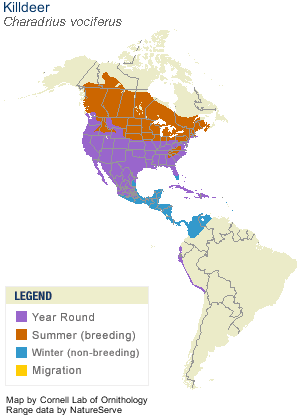 SKC Films Library SKC Films Library |
| SKC Films Library >> Science >> Zoology >> Birds >> Order Charadriiformes |
| Killdeer Charadrius vociferus [kar ad rE' uhs vO sif' er uhs]
Decription The killdeer is 8-11 inches long, and has a wingspan of 18-19 inches. It has brown upper feathers and a white underside, a brown head with black band between the eyes, white 'eyebrows,' and black bands around the upper chest. The bill is sharp and black, and the legs and tail are long. Males and females are the same size and have identical coloring. Distribution and Habitat The killdeer's summer range extends from Alaska east to Newfoundland, south to southern Mexico and the Caribbean; there are also scattered populations in Costa Rica, coastal Peru, and northwestern Chile. Its winter range extends from British Columbia to the Ohio Valley and Massachusetts, south throughout most of the United States, and into Central and extreme northern Southern America.
Killdeer are very adaptable, and live quite well in a variety of habitats, including open grasslands, wetlands, fields, croplands, pastures, short-grass prairies, sandbars, and mudflats. They are very tolerant of human civilization, and have even been known to nest in the midst of heavy traffic areas, and in some urban areas have even been known to nest on graveled rooftops. Despite being classed as a "shorebird," killdeer prefer to nest in areas far from water. Reproduction Breeding usually takes place in April and May. The male selects a nesting territory before selecting a mate, which he will attempt to attract by standing in his territory and making a two-note call for hours at a time until the right female "takes him up on his offer." The nest is little more than a unlined shallow depression on the open ground, usually located in a graveled area. An average of four speckled eggs are laid per clutch. The eggs are pointed, relatively large, and so colored as to literally "blend into" the gravel in which they are laid. Incubation does not begin until all eggs are laid, meaning that all chicks will hatch at the same time regardless of how long it takes for the clutch to be laid. Both parents share in incubation, which takes 24-28 days. Chicks hatch with their eyes open and can begin running about as soon as they are dry, but still rely on their parents for food and protection. Killdeer parents are famous for their "broken wing" displays, which they use to distract potential threats to their chicks. If someone approaches the nest or chicks, the parent will flop around on the ground as if injured. If approached, it will manage to stay just out of reach until the intruder has been drawn a safe distance away and then "miraculously" get up and fly away. If a "dumb" animal gets too close it will fluff itself up, display its tail up over its head, and run at the animal in an effort to chase it away. Chicks fledge at about one month. A breeding pair may have two broods in one year, depending on local conditions. Diet The primary diet consists of insects, but some berries and crustaceans are also eaten. In agricultural areas, killdeer will often follow agricultural plows and take up exposed worms. Scientific Classification Phylum Chordata SOURCES |
| SKC Films Library
>> Science
>> Zoology >> Birds >> Order Charadriiformes This page was last updated on June 16, 2017. |

